We have been away for a few days to install a kiln.
I had sent the finished kiln away on a truck 10 days earlier with instructions for its safe delivery to the site of the installation. Down the back street, up the lane, around down the ally and hey presto. Into the back entrance straight into the studio area. I made sure that all these instructions were on the delivery docket and also taped to the front of the kiln itself. All there along with our mobile and land-line phone numbers and email.
As well as instruction to call us before delivery to confirm time and place etc. 10 days should be enough.
What could possibly go wrong?
The people at the trucking company in my local town were really helpful and very professional, even careful, while unloading the kiln from my truck and placing it in the depot shed. I left with every confidence that they would ‘do the right thing’. A lot of work goes into building one of my kilns for a customer. I spend about 6 weeks working on it, from cutting, folding, bending, then tacking and welding all the steel sections that are needed to frame up a kiln.
There are some sections that are very hard to get commercially or just plain not available at some times, so I have to cut these out of flat steel plate, then fold them into the required cross-section. None of this is in any way efficient, but when you are creating custom-built objects it is just what is required, especially if you want the very best outcome and excellent quality. You just have to do it yourself.
Next there is the guillotining, breaking, bending, and drilling, bolting and fitting all the stainless steel sheeting that comprise the walls and floor of the kiln. These all have to made and measured to make sure that they will all fit and then the holes drilled in the frame before it is galvanised. This is so that the holes for the stainless steel bolts will be lined with zinc and permanently rust proofed. There is no use drilling a lot of holes through the rust proofing to set all the bolts.
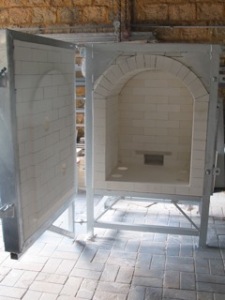
The mild steel frame is stripped down and sent off to be hot dipped galvanised, which means that it is dipped into a bath of molten zinc. After this it is almost permanently rust proofed. While the kiln frame is away, I silver solder all the heavy gauge copper pipe gas manifold and commence building the gas burners and safety train from basic rough castings. When the frame has been galvanised. It all gets assembled and put together, so that it is ready for the brick lining to be laid inside.
A kiln is a very complex thing and almost every brick that is laid in it has to be custom shaped in some way or other, so as to get a perfect fit for the ground face door seal and all the other intricate parts, like arch bricks that make it perfect, and not just ordinary. Everything takes time, but it’s the only way, if you want excellence.
Having spent all this time on a job like this. I want it to arrive in just the same perfect condition that it left my workshop in. So on the appointed day, we sit and wait for the phone call. it doesn’t come at 8.00 am as I was hoping, or at 9 or 10, so I ring the trucking depot to see what has happened to it. They casually tell me that they were just talking about me. The truck has broken down, the cheque is in the mail and some of their best friends are Jewish! Do I detect a lie?
Do I still want the kiln delivered today? is he joking?
He can probably get it here, but not on a crane truck. He can probably hire a tail-gate lift truck to do it, but not till later in the afternoon. Will that be OK?
I’m snookered, reluctantly, I have to agree, I’ve pre-paid the delivery in advance. It has to be delivered today, everything is in place for it to happen. The plumber is coming a 3.00 pm to connect it. That clearly isn’t going to happen today as planned, but I’ve already booked some thing else for tomorrow. They have had 10 days to think about this and get ready. It’s all a bit laxadaisical and shoddy, quite unprofessional. So we sit and wait for the truck. It arrives around 3.00 pm and a very nice young driver, who is very helpful. He tells me that the depot that he picked the kiln up from is quite chaotic.
Still, the kiln is here now and undamaged. I’m so relieved! We lift it down off the truck using a pallet jack trolley on the tail gate lifter. But unfortunately, the very thoughtful people in the original trucking depot in my home town have strapped it to a pallet for safe, stable travel. Very thoughtful of them. But it is now too high to go through the door into the studio, and we have no means to lift it to get the pallet out from underneath. All these measurements were carefully made in advance and everything planned and measured twice and confirmed. We are completely stuck. I’m away from home in another city with no access to my workshop and tools with chain blocks, lifting gear, pulleys, jacks, slings and shackles, beams and levers. Here, I only have a spanner, which is all that I should have needed.
There is no option but to try and get a crane truck out here before dark, so that we can lift the kiln up, all three quarters of a tonne of it, remove the pallet and then wheel it into the studio on the pallet jack before dark. I don’t want to leave it here out side in the alley over night.
My amazing customer rings around and finds a crane truck that can come at short notice, before dark and do the job. Unfortunately, he arrives with a semi-trailer truck 20 or more metres long with crane on the prime mover and can hardly fit in the street, never mind get up the lane and down the ally.
The truck arrives and takes one look at the narrow lane and shakes his head. There is no way. If he could unhitch his semi-trailer some where safe? He needs to park his trailer in this street somewhere, but there isn’t anywhere close by, However, there is a gap in the parked cars, a few doors back on the opposite side on a corner. Could it just fit there? He decides to park it there. There are street trees and it will block at least one drive way and we can expect a few home owners returning home at this time of the evening. My beautiful client, volunteers to wait with the semi-trailer unit until we are all done, she’ll explain to the home owner if he returns at this point, why his driveway is blocked.
He does turn up!
She is very diplomatic. She directs him up the lane, where there is some room to park. He is gracious and friendly and very obliging.
While the very helpful and patient truckie is reversing his trailer into position, he nudges a low hanging branch of a street tree on the curb-side. Tragically, it snaps off while he is parking his charge. This shouldn’t be a big problem, as the branch is low hanging, but just our luck, a lady who lives on the corner house is temporarily off her meds, and comes out see the manoeuvre. She starts to scream at the driver. She unleashes a torrent of abuse that brings more people into the street, she threatens him, she’ll sue! She’s a total nutter. He has apparently done it to abuse her and to cause her distress. Of course, he hasn’t, he’s a nice, helpful guy, but she can’t see that in her ‘off-her-meds’, deluded state. She threatens to call the cops!
And does!
Just at this point the local homeless drunk turns up, wandering down the street swigging from his bottle, and decides that he’ll give us a hand. A hand that we don’t need, or want. He begins by swaying out into the street and directing traffic, then hearing the verbal conflict, lurches over to the corner, “I’ll sort things out for Ya” he slurs, as he starts to scream abuse back at the distressed lady, face to face, red faced and veins throbbing in his forehead, bright red nose, holding his bottle aloft and swinging it about, he issues a long abusive stream of invective and a meaningless expression of anxieties unfolds. “Ya f*&%$ing old bitch, why don’tya get off the f*&%$ing dole and get a f*&%$ing job. Yarra f*&%$ing bludga! Shut up ya f*&%$ing face and get the f*&%k outa-ere!”.
“I dunna why she’s so upset, I’m just tryin a elp”. She storms off to call the Cops.
This in-flames things even more. This is help we don’t need. I wish that he would just go away, but that isn’t very likely. He’s a complete nuisance and appears to be off-his-meds too, just like her, and they slug it out mercilessly between each other, verbally for quite some time. He calls out, “sure, go and call the Cops, see if I care!” She does and they arrive very quickly. When the Police car turns up. They witness some of the ‘meds-free- zone’ invective and stay clear, for their own safety. Just watching at first. I’m sure that they have seen it all before, many times, and don’t want to get too involved with nutters. My sweet, calm and well mannered client goes over to explain to them what has happened. They listen, but tell her that they will issue the truckie with a move your illegally parked vehicle notice, effective immediately. This isn’t good news, but she is calm and persuasive. They listen.
As soon as the Police car appears, the drunk moves off smartly up the ally. Now to give me and the driver a helping hand. He slumps down against the fence and swigs from another bottle that he has stashed in his coat pocket. He is calling out instructions to the driver on how to reverse his big prime mover and crane.
I discreetly escort the prime-mover with crane attached, up the lane, to our site, while my sweet, patient, client does her explaining and waits near the blocked off driveway for the returning home-owners, then helps to calm down the situation with the police, carefully and quietly explaining the circumstances of the events. The truck backs up to our site, but declares that there are too many cars parked in the lane for him to be able to reverse into position.
While we are working out how to solve this next problem. The Police officer arrives up the lane. We explain carefully and quietly what our mission is. I try to explain, that it is very hard to be a truckie in a modern city. Every one wants their goods delivered, but no-one likes to be inconvenienced. We are trying to do this as legally and safely as we can given the circumstances. The driver is only doing his job, no-one wants conflict. It’s a difficult balancing act to get a difficult job done and not inconveniencing anyone in the mean time. Everyone needs to get a truck to deliver their goods at some point in their life. It’s a tricky and difficult job, but absolutely essential in the modern age. My client invites the very nice young police man into her studio to show him her work and where the kiln will go. He responds appropriately and gives the truckie a one-hour grace to complete the job. All the neighbours are now placated and safely parked. Mr. Helpful – the drunk, has disappeared on first sight of the blue uniform, thank goodness. The Officer walks back down the lane to his car.

The the crane operator now has a one hour leave of grace to do his difficult job. I feel for him, one minute, he is being abused by a nutter, then the next by a drunk. All he wants to do is to do his job, with as much care as he can muster. He is quietly spoken and very careful. I feel for him. He expresses great remorse at the broken tree branch. He tried to avoid it. It was hanging very low. If not now, then some other time a delivery truck would have caught it.
The copper leaves, taking no notice of the stream of invective coming from across the street.
We get the kiln lifted off the pallet, an hours work for just a 6” lift, taking just a few seconds. Success! The kiln is now able to be wheeled into place in just 60 seconds, and it’s all over. 9 hours later!
It’s a simple job to deliver a kiln. What could possibly go wrong?
Best wishes
from the kiln delivery man


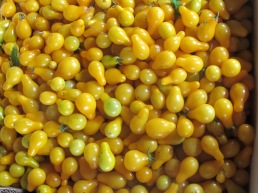






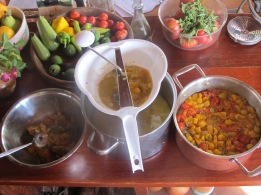




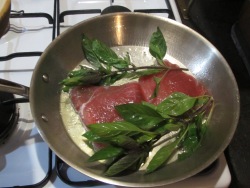




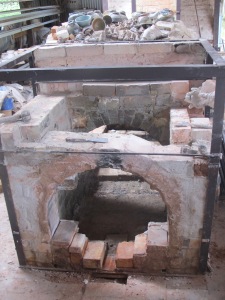




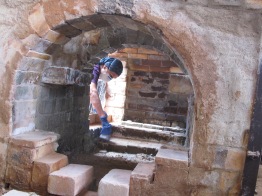
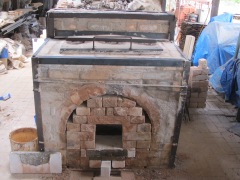

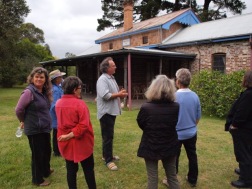






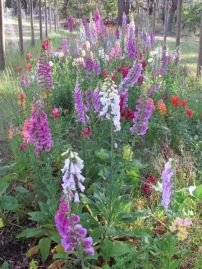
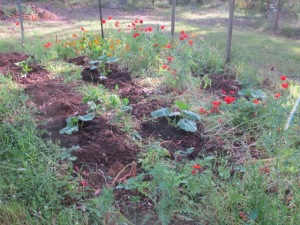








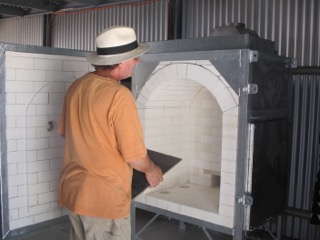
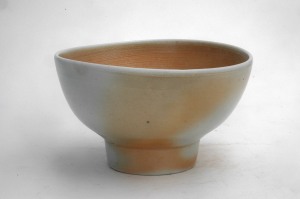
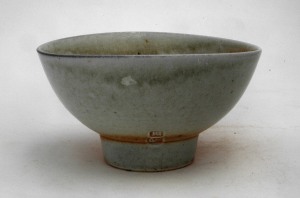
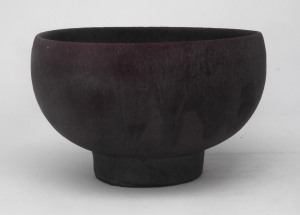

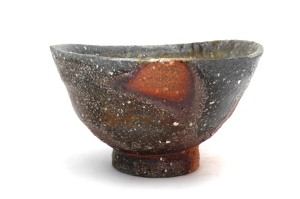
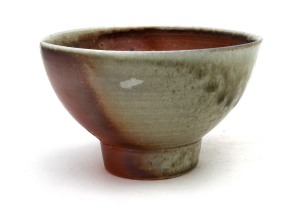




You must be logged in to post a comment.